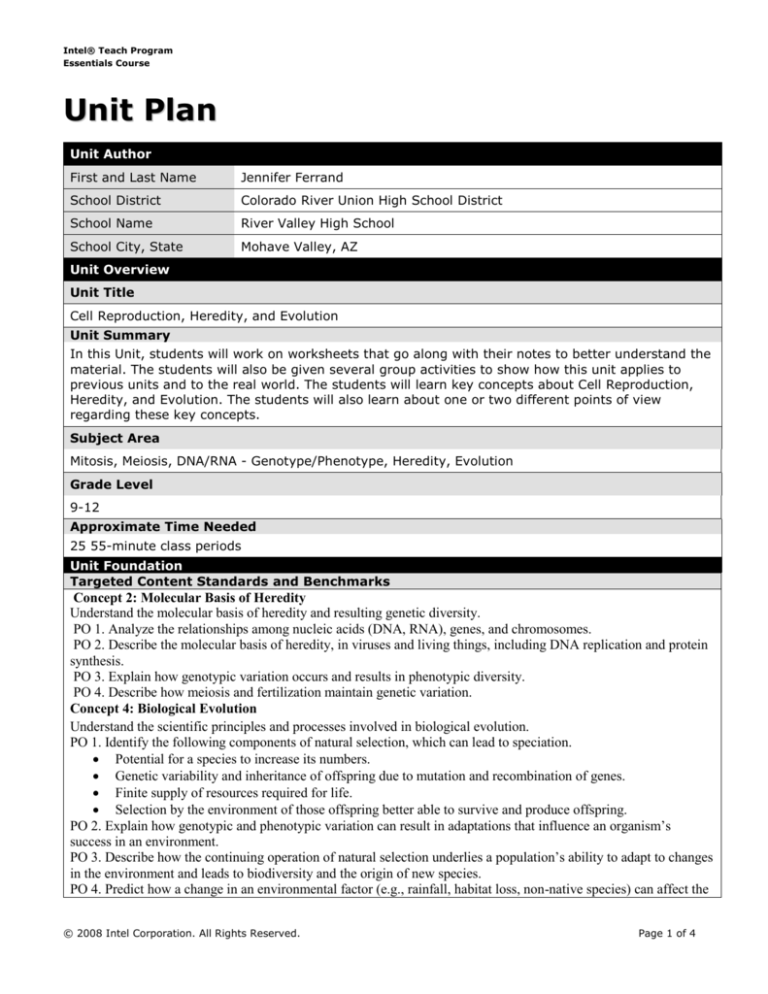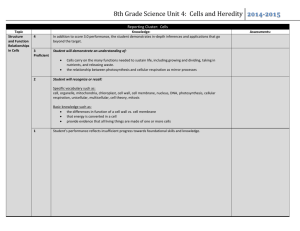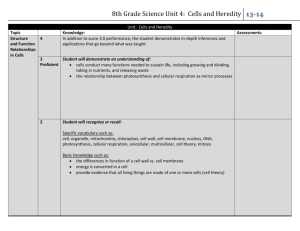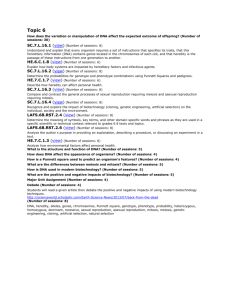
Intel® Teach Program
Essentials Course
Unit Plan
Unit Author
First and Last Name
Jennifer Ferrand
School District
Colorado River Union High School District
School Name
River Valley High School
School City, State
Mohave Valley, AZ
Unit Overview
Unit Title
Cell Reproduction, Heredity, and Evolution
Unit Summary
In this Unit, students will work on worksheets that go along with their notes to better understand the
material. The students will also be given several group activities to show how this unit applies to
previous units and to the real world. The students will learn key concepts about Cell Reproduction,
Heredity, and Evolution. The students will also learn about one or two different points of view
regarding these key concepts.
Subject Area
Mitosis, Meiosis, DNA/RNA - Genotype/Phenotype, Heredity, Evolution
Grade Level
9-12
Approximate Time Needed
25 55-minute class periods
Unit Foundation
Targeted Content Standards and Benchmarks
Concept 2: Molecular Basis of Heredity
Understand the molecular basis of heredity and resulting genetic diversity.
PO 1. Analyze the relationships among nucleic acids (DNA, RNA), genes, and chromosomes.
PO 2. Describe the molecular basis of heredity, in viruses and living things, including DNA replication and protein
synthesis.
PO 3. Explain how genotypic variation occurs and results in phenotypic diversity.
PO 4. Describe how meiosis and fertilization maintain genetic variation.
Concept 4: Biological Evolution
Understand the scientific principles and processes involved in biological evolution.
PO 1. Identify the following components of natural selection, which can lead to speciation.
Potential for a species to increase its numbers.
Genetic variability and inheritance of offspring due to mutation and recombination of genes.
Finite supply of resources required for life.
Selection by the environment of those offspring better able to survive and produce offspring.
PO 2. Explain how genotypic and phenotypic variation can result in adaptations that influence an organism’s
success in an environment.
PO 3. Describe how the continuing operation of natural selection underlies a population’s ability to adapt to changes
in the environment and leads to biodiversity and the origin of new species.
PO 4. Predict how a change in an environmental factor (e.g., rainfall, habitat loss, non-native species) can affect the
© 2008 Intel Corporation. All Rights Reserved.
Page 1 of 4
Intel® Teach Program
Essentials Course
number and diversity of species in an ecosystem.
PO 5. Analyze how patterns in the fossil record, nuclear chemistry, geology, molecular biology, and geographical
distribution give support to the theory of organic evolution through natural selection over billions of years and the
resulting present day biodiversity.
PO 6. Analyze using a biological classification system (i.e., cladistics, phylogeny, morphology, DNA analysis), the
degree of relatedness among various species.
21st Century Skill:
Critical Thinking and Systems Thinking.
Problem Identification, Formulation, and Solution.
Accountability and Adaptability,
Self-Direction
Interpersonal and Collaborative skills.
Student Objectives/Learning Outcomes
The students will learn:
Mitosis Phases, Meiosis Phases, DNA/RNA, Heredity, Evolution, Real World Applications
Curriculum-Framing Questions
Essential
What does it take to change the world?
Question
Unit
Why do organisms need to reproduce?
Questions
What is heredity?
What is evolution?
What are the key components of heredity and evolution?
Content
Questions
What is DNA/RNA?
What is a genotype/phenotype?
What are the similarities between DNA and RNA, genotype and phenotype,
mitosis and meiosis?
What is mitosis/meiosis?
Assessment Plan
Assessment Timeline
Before project work begins
Students work on projects
and complete tasks
Sequencing
Notebook/
Classification
Journals
Project Plan
Questioning
K-W-L Chart
Checklist
Group and Self Assessment
After project work is
completed
Peer Review
Stude
an
Reflective Essay
Assessment Summary
The students will work on worksheets that go along with their notes to better understand the
material. The students will also be given several group activities to show how this unit applies to
previous units and to the real world. The students will learn key concepts about Cell Reproduction,
Heredity, and Evolution. The students will also learn about one or two different points of view
regarding these key concepts.
© 2008 Intel Corporation. All Rights Reserved.
Page 2 of 4
Intel® Teach Program
Essentials Course
Unit Details
Prerequisite Skills
The student should know the characteristics of life, the different types of cells, and the parts of the
cells.
Instructional Procedures
Schedule of work – Informal Assessments (CFQ’s, Differentiation), Worksheets (student SelfDirection), and Formal Assessments (CFQ’s) will be given every week based on the topic(s) they will
be going over.
Week 1 – Mitosis
Week 2 – Meiosis
Week 3 – DNA
Week 4 – Heredity: Genotype, Phenotype, DNA, RNA
Week 5 – Evolution
Accommodations for Differentiated Instruction
Special Needs
Students
Nonnative
Speakers
Gifted/Talented
Students
Selection of an appropriate skill or strategy for instruction
Labeling and categorizing of the skill
Modeling of the skill through a think-aloud
Guided practice of the skill with a partner or small group
Explanation of how and when to use the skill or strategy
Ongoing coaching on how to use the skill effectively
Speak in natural, but slower speech.
Use shorter sentences with simpler syntax.
Pause frequently to allow students to process what has been said.
Use consistent vocabulary.
Repeat information appropriately.
Use gestures and body language to support and demonstrate concepts.
Develop consistent routines and signals for classroom processes.
Present information in a variety of ways, such as verbally, on the board, and in
handouts.
Smaller leaps to greater leaps—More advanced students can often accomplish
tasks that require greater cognitive leaps in insight, application, or transfer than
their peers.
Simple to complex—Advanced students benefit from projects that involve
complex resources, research, issues, problems, skills, or goals.
Materials and Resources Required For Unit
Technology – Hardware (Click boxes of all equipment needed)
Camera
Laser Disk
VCR
Computer(s)
Printer
Video Camera
Digital Camera
Projection System
Video Conferencing Equip.
DVD Player
Scanner
Other
Internet Connection
Television
Technology – Software (Click boxes of all software needed.)
Database/Spreadsheet
Image Processing
Web Page Development
Desktop Publishing
Internet Web Browser
Word Processing
E-mail Software
Multimedia
Other
Encyclopedia on CD-ROM
© 2008 Intel Corporation. All Rights Reserved.
Page 3 of 4
Intel® Teach Program
Essentials Course
Printed Materials
N/A
Supplies
N/A
Internet Resources
N/A
Other Resources
N/A
Programs of the Intel® Education Initiative are funded by the Intel Foundation and Intel Corporation.
Copyright © 2007, Intel Corporation. All rights reserved. Intel, the Intel logo, Intel Education Initiative, and Intel Teach Program are
trademarks of Intel Corporation in the U.S. and other countries. *Other names and brands may be claimed as the property of others.
© 2000-2007 Intel Corporation. All Rights Reserved.
Page 4 of 4









